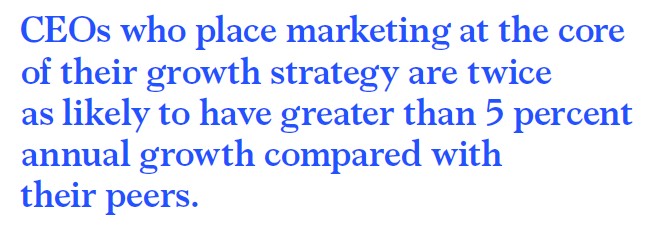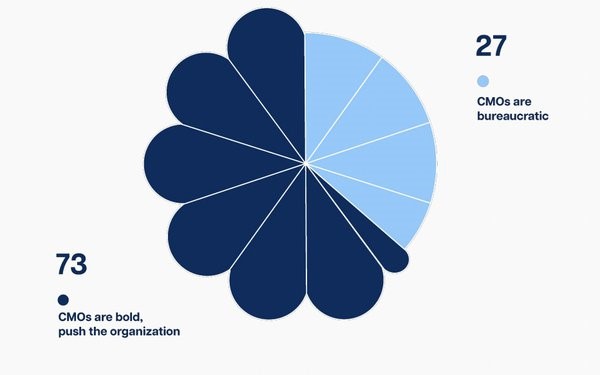
Transcending the CEO-CMO Understanding Gap
There’s little doubt that the CEO-CMO relationship is business critical.
The last few months have seen several authoritative studies that consider CEOs’ understanding of marketing, as well as their perceptions of CMO performance. While there are obvious differences in the research, when the studies are looked at together, several interesting trends emerge that paint a more complete picture of an enhanced role that marketing can play for the betterment of business.
“I’ve yet to see two org charts that show any similarities in CMO roles. We find a uniqueness in how a company defines a Chief Marketing Officer. However, if we look at a CFO job description, for example, 80% of what’s outlined is comparable among companies and across industries. Plus, given the new complexities and increased responsibilities of marketing itself, there is now some fragmentation in top marketer titles, which is why we’re seeing new terms like Chief Brand Officer or Chief Customer Officer.”
Richard Sanderson- Marketing, Sales & Communications Officer Practice Leader, Spencer Stuart
I was amazed when I heard this from Richard Sanderson as he shared findings from Spencer Stuart’s 19th annual CMO Tenure Study at the ANA’s Masters of B2B in late 2023. Interestingly, the comments above were not part of his speech but were candid responses from the follow-up Q&A session. No wonder there is so much confusion—not only in CMO roles and tenure but in new job titles that seem to augment, rather than entirely replace, the complex top marketing assignment.
Clearly, as the role of Chief Marketer continues to evolve and grow in complexity, CEOs must not only clarify responsibilities but also create a measurable framework for success.
According to McKinsey’s study, The Power of Partnership: How the CEO–CMO Relationship Can Drive Outsize Growth, “CEOs who place marketing at the core of their growth strategy are twice as likely to have greater than 5 percent annual growth compared with their peers.” That statistic may be one of the most important qualifications for the importance of marketing within the organization.

Yet, the same McKinsey study showed a significant disconnect in marketing understanding: “There is a difference in perception about modern marketing capabilities reflected in responses to our survey question about modern marketing. When we asked about familiarity with tactics such as paid social, personalization, and advanced targeted strategies, about 50 percent of our CEO respondents said they feel comfortable with modern marketing. However, 66 percent of the CMOs we surveyed said their CEOs were not comfortable with modern marketing.”
Contributing to this gap is the fact that most CEOs lack a marketing background. Based on publicly available data, McKinsey estimates, “Only 10 percent of Fortune 250 CEOs have marketing experience, and only 4 percent have previously held a CMO-like role. In contrast, more than 70 percent of Fortune 100 CEOs have an operations or finance background. It stands to follow, then, that many C-suite members underestimate marketing’s potential to create growth, despite the rapid growth in marketing capabilities.”
Surprisingly, McKinsey also found that more than 40 percent of Fortune 500 companies don’t have a growth- or customer-related role among their CEO’s executive committee. “That means marketing or
marketing-adjacent leaders can struggle to deliver when they are not part of the strategic conversation and may not have the opportunity to influence important decisions.”
To bridge this gap, McKinsey’s suggestions echoed those of Spencer Stuart’s Richard Sanderson. CEOs must clarify the top marketer’s role, understand how a CMO contributes to growth, and create a clear measurement framework.
The Power of Partnership also outlined four key CMO roles and recommended that CEOs should decide what kind of role they want their CMOs to play:
- Sales-Force Enabler: Enables sales by providing design support and other sales tools; provides the long-term perspective and investment that complements sales organizations.
- Brand Steward: Sets the North Star for the company brand and reputation, as activated through advertising, public relations, and communications.
- Demand Capture Engine: Uses omnichannel tactics—such as affiliate marketing, search engine marketing, and social media marketing—to capture customer demand.
- Customer Experience and Personalization Ambassador: Delivers a world-class customer experience and strengthens customer relationships through targeted loyalty programs and personalized communications.
Many CMOs have multiple roles as outlined above, while some organizations are building new titles for specific areas.
Finally, the most recent (and most positive) data comes from Boathouse, an independent, integrated marketing and communications agency with three US offices. Their Third Annual CEO Study on Marketing and the CMO underscores how marketers now receive better grades from their CEOs than in previous years. According to Boathouse insights from 150 CEOs at top US public and private companies across 17 industries, Chief Executives say that 87% of CMOs understand their vision and 80% take action to execute that vision. Plus 73% say their CMOs are bold and push the organization forward.

Boathouse also asked CEOs to grade the overall performance of their CMOs. Twenty-six percent of CMOs received an “A,” an increase from just 16% the prior year. Nearly half (47%) of CMOs received a “B” and 25% were given a “C.”
According to Boathouse CEO John Conners, the pandemic helped CMOs become smarter as they had to focus not only on customers but employees, DEI, supply chain issues, and business operations. This helped to align them with the CEO’s perspective. “I think CMOs have gotten more experienced with business issues through COVID,” says Conners, “and CEOs see them as more of a business partner.”
And this is good news for everyone in business.



